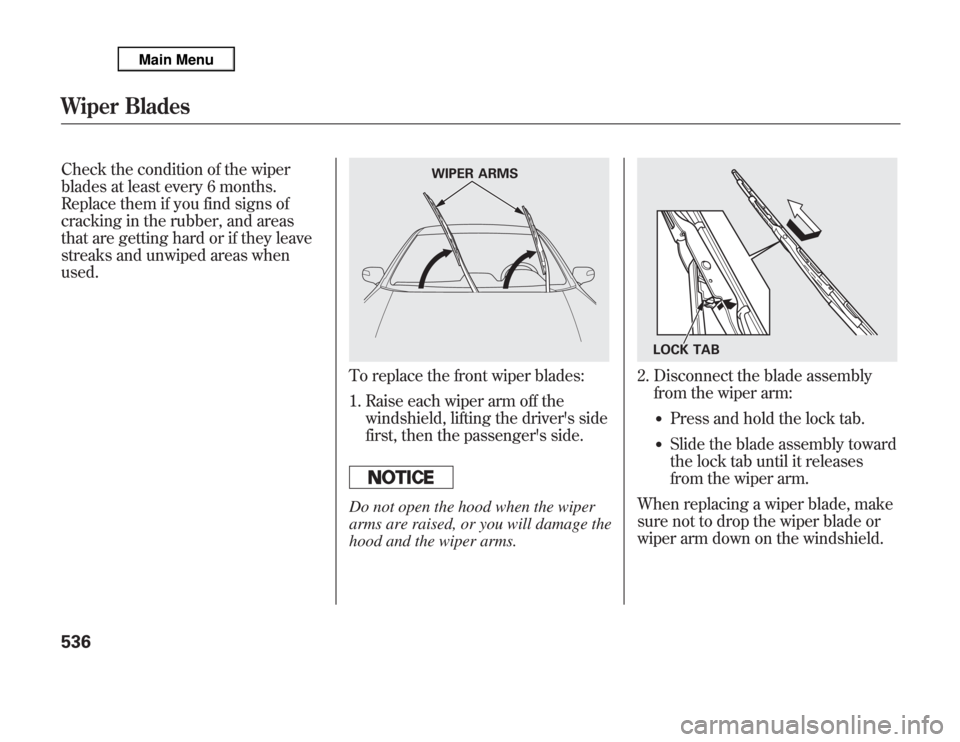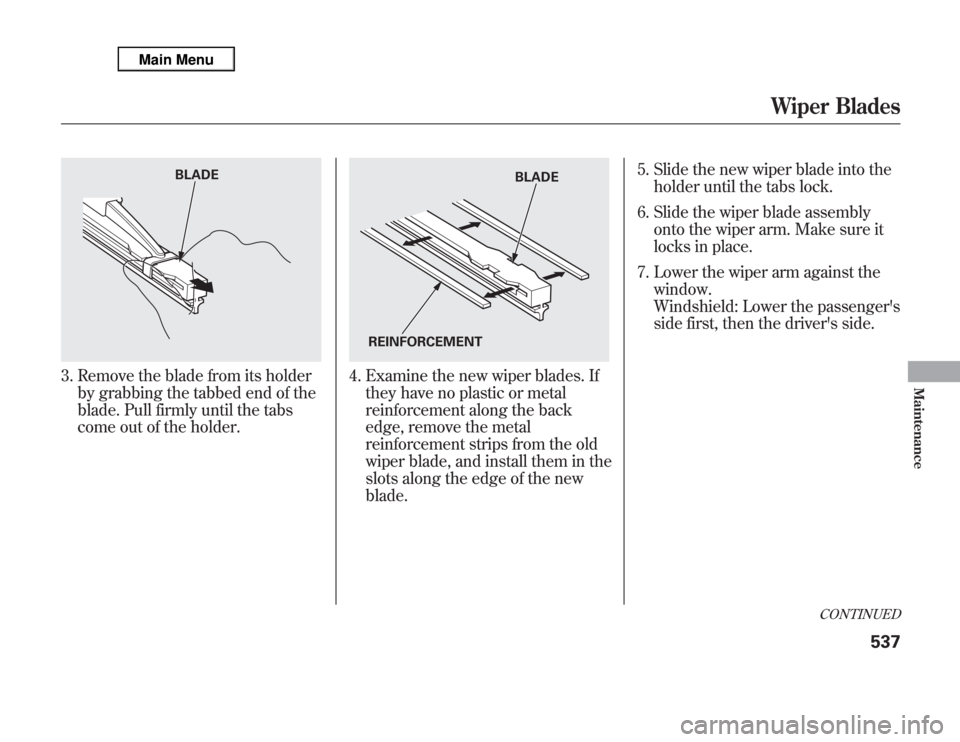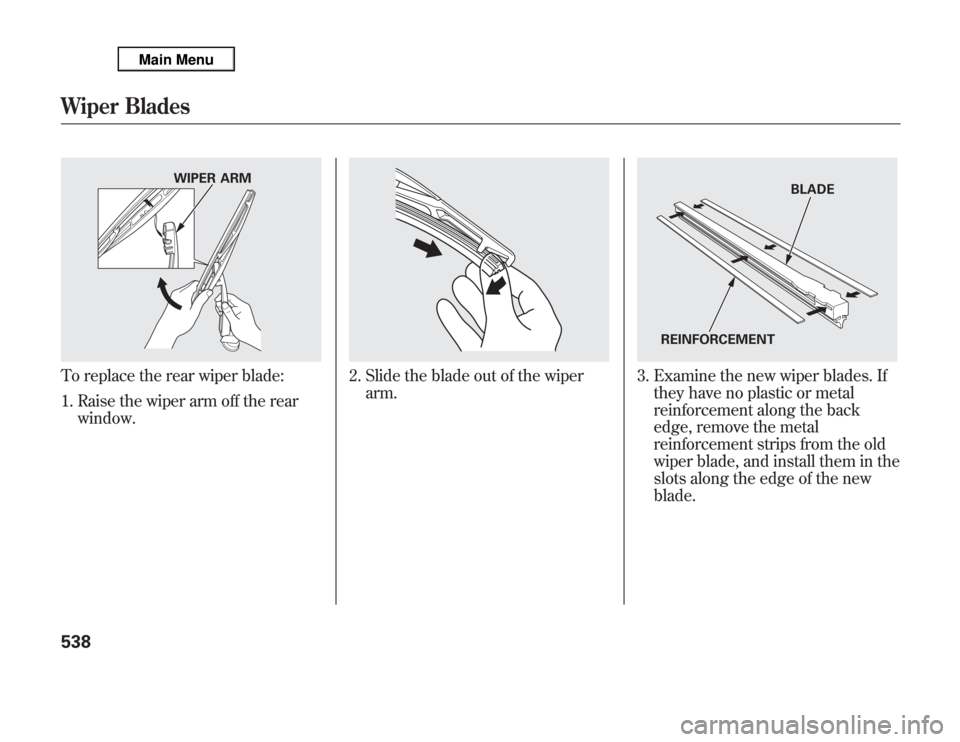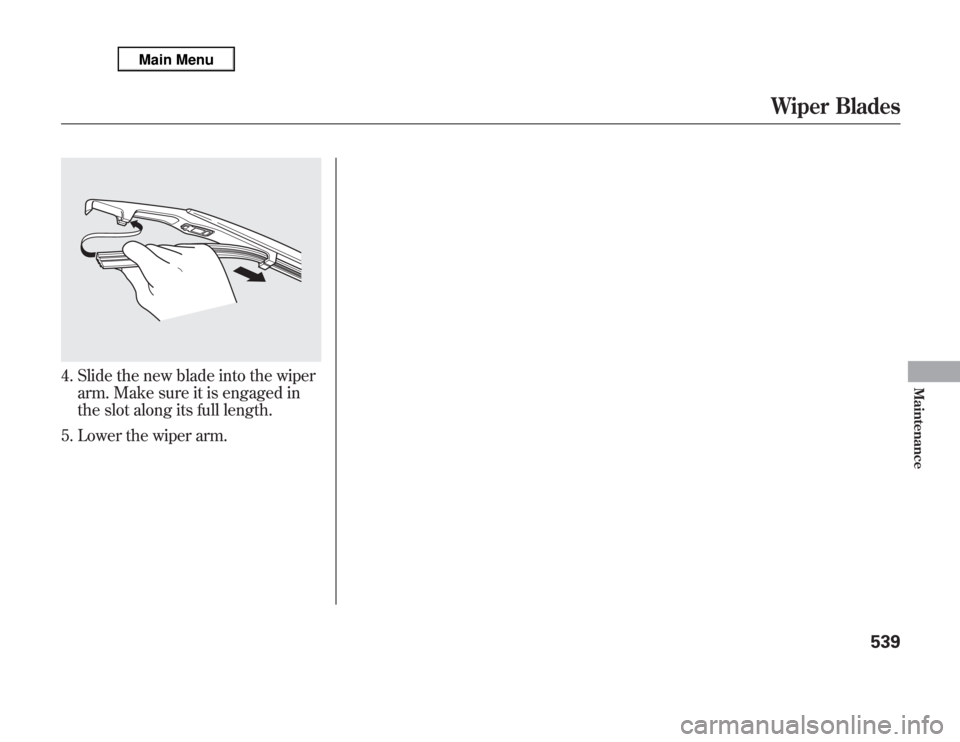Acura MDX 2012 Owner's Manual
Manufacturer: ACURA, Model Year: 2012, Model line: MDX, Model: Acura MDX 2012Pages: 621, PDF Size: 11.15 MB
Page 541 of 621

Dust and Pollen Filter
This filter removes the dust and
pollen that is brought in from the
outside through the climate control
system.
Have your dealer replace the filter
when this service is indicated by a
maintenance message on the multi-
information display. It should be
replaced every 15,000 miles (24,000
km) if you drive primarily in urban
areas that have high concentrations
of soot in the air, or if the flow from
the climate control system becomes
less than usual.Cleaning the Seat Belts
If your seat belts get dirty, use a soft
brush with a mixture of mild soap
and warm water to clean them. Do
not use bleach, dye, or cleaning
solvents. Let the belts air-dry before
you use the vehicle.Dirt build-up around the openings of
the seat belt anchors can cause the
belts to retract slowly. Wipe the
openings with a clean cloth
dampened in mild soap and warm
water or isopropyl alcohol.
OPENING
Dust and Pollen Filter, Cleaning the Seat Belts534
Page 542 of 621

The floor mats that came with your
vehicle hook over the floor mat
anchors. This keeps the floor mats
from sliding forward, possibly
interfering with the pedals, or
backwards, making the front
passenger's weight sensors
ineffective.
If you remove a floor mat, make sure
to re-anchor it when you put it back
in your vehicle.
If you use a non-Acura floor mat,
make sure it fits properly and that it
can be used with the floor mat
anchors. Do not put additional floor
mats on top of the anchored mats.
Front
Rear
Floor Mats
535
Maintenance
Page 543 of 621

Check the condition of the wiper
blades at least every 6 months.
Replace them if you find signs of
cracking in the rubber, and areas
that are getting hard or if they leave
streaks and unwiped areas when
used.
To replace the front wiper blades:
1. Raise each wiper arm off the
windshield, lifting the driver's side
first, then the passenger's side.Do not open the hood when the wiper
arms are raised, or you will damage the
hood and the wiper arms.
2. Disconnect the blade assembly
from the wiper arm:
●
Press and hold the lock tab.
●
Slide the blade assembly toward
the lock tab until it releases
from the wiper arm.
When replacing a wiper blade, make
sure not to drop the wiper blade or
wiper arm down on the windshield.
WIPER ARMS
LOCK TAB
Wiper Blades536
Page 544 of 621

3. Remove the blade from its holder
by grabbing the tabbed end of the
blade. Pull firmly until the tabs
come out of the holder.
4. Examine the new wiper blades. If
they have no plastic or metal
reinforcement along the back
edge, remove the metal
reinforcement strips from the old
wiper blade, and install them in the
slots along the edge of the new
blade.5. Slide the new wiper blade into the
holder until the tabs lock.
6. Slide the wiper blade assembly
onto the wiper arm. Make sure it
locks in place.
7. Lower the wiper arm against the
window.
Windshield: Lower the passenger's
side first, then the driver's side.
BLADE
BLADE
REINFORCEMENT
CONTINUED
Wiper Blades
537
Maintenance
Page 545 of 621

To replace the rear wiper blade:
1. Raise the wiper arm off the rear
window.
2. Slide the blade out of the wiper
arm.
3. Examine the new wiper blades. If
they have no plastic or metal
reinforcement along the back
edge, remove the metal
reinforcement strips from the old
wiper blade, and install them in the
slots along the edge of the new
blade.
WIPER ARM
BLADE
REINFORCEMENT
Wiper Blades538
Page 546 of 621

4. Slide the new blade into the wiper
arm. Make sure it is engaged in
the slot along its full length.
5. Lower the wiper arm.
Wiper Blades
539
Maintenance
Page 547 of 621

To safely operate your vehicle, your
tires must be the proper type and
size, in good condition with adequate
tread, and correctly inflated.
The following pages give more
detailed information on how to take
care of your tires and what to do
when they need to be replaced.
Using tires that are excessively
worn or improperly inflated can
cause a crash in which you can
be seriously hurt or killed.
Follow all instructions in this
owner's manual regarding tire
inflation and maintenance.Inflation Guidelines
Keeping the tires properly inflated
provides the best combination of
handling, tread life, and riding
comfort.
●
Underinflated tires wear unevenly,
adversely affect handling and fuel
economy, and are more likely to
fail from being overheated.
●
Overinflated tires can make your
vehicle ride more harshly, are
more prone to damage from road
hazards, and wear unevenly.
The tire pressure monitoring system
(TPMS) warns you when a tire
pressure is low. See page 455 for
more information.
Even though your vehicle is
equipped with TPMS, we
recommend that you visually check
your tires every day. If you think a
tire might be low, check it
immediately with a tire gauge.Use a gauge to measure the air
pressure in each tire at least once a
month. Even tires that are in good
condition may lose 1 to 2 psi (10 to
20 kPa, 0.1 to 0.2 kgf/cm
2) per
month. Remember to check the
spare tire at the same time.
Tires540
Page 548 of 621

Check the air pressures when the
tires are cold. This means the vehicle
has been parked for at least 3 hours,
or driven less than 1 mile (1.6 km).
Add or release air, if needed, to
match the recommended cold tire
pressures.
If you check air pressures when the
tires are hot [driven for several miles
(kilometers)], you will see readings 4
to 6 psi (30 to 40 kPa, 0.3 to 0.4
kgf/cm
2) higher than the cold
readings. This is normal. Do not let
air out to match the recommended
cold air pressure. The tire will be
underinflated.
While tubeless tires have some
ability to self-seal if they are
punctured, you should look closely
for punctures if a tire starts losing
pressure.You should get your own tire
pressure gauge and use it whenever
you check your tire pressures. This
will make it easier for you to tell if a
pressure loss is due to a tire problem
and not due to a variation between
gauges.
Recommended Tire Pressures
The following chart shows the
recommended cold tire pressures for
most normal driving conditions.
MDX, Technology Package, and U.S.
Technology Package with Entertainment
models
Tire Size Cold Tire Pressure
for Normal Driving
255/55R18 105H Front/Rear:
32 psi (220 kPa, 2.2
kgf/cm
2)
U.S. Advance Package, Advance
Package with Entertainment, and
Canadian Elite Package models
Tire Size Cold Tire Pressure
for Normal Driving
P255/50R19 103H Front/Rear:
32 psi (220 kPa, 2.2
kgf/cm
2)
The compact spare tire pressure is:
60 psi (420 kPa, 4.2 kgf/cm
2)
For convenience, the recommended
tire sizes and cold tire pressures are
on a label on the driver's doorjamb.
For additional information about your
tires, see page 581.
CONTINUED
Tires
541
Maintenance
Page 549 of 621

High Speed Driving
We strongly recommend that you do
not drive faster than the posted
speed limits and conditions allow. If
you ever drive in a sanctioned
competitive event at sustained high
speeds (over 99 mph or 160 km/h),
be sure to adjust the cold tire
pressures as shown below. If you do
not, excessive heat can build up and
cause sudden tire failure.MDX, Technology Package, and U.S.
Technology Package with Entertainment
models
Tire Size Cold Tire Pressure for
High Speed Driving
255/55R18 105H Front: 32 psi (220 kPa,
2.2 kgf/cm
2)
Rear: 33 psi (230 kPa,
2.3 kgf/cm2)
U.S. Advance Package, Advance
Package with Entertainment, and
Canadian Elite Package models
Tire Size Cold Tire Pressure for
High Speed Driving
P255/50R19 103H Front: 33 psi (230 kPa,
2.3 kgf/cm
2)
Rear: 36 psi (260 kPa,
2.6 kgf/cm2)
Tire Inspection
Every time you check inflation, you
should also examine the tires for
damage, foreign objects, and wear.
You should look for:●
Bumps or bulges in the tread or
side of the tire. Replace the tire if
you find either of these conditions.
●
Cuts, splits, or cracks in the side of
the tire. Replace the tire if you can
see fabric or cord.
●
Excessive tread wear.
Tires542
Page 550 of 621

Your tires have wear indicators
molded into the tread. When the
tread wears down, you will see a 1/2
inch (12.7 mm) wide band across the
tread. This shows there is less than
1/16 inch (1.6 mm) of tread left on
the tire.
A tire this worn gives very little
traction on wet roads. You should
replace the tire if you can see three
or more tread wear indicators.Tire Service Life
The service life of your tires is
dependent on many factors,
including, but not limited to, driving
habits, road conditions, vehicle
loading, inflation pressure,
maintenance history, speed, and
environmental conditions (even
when the tires are not in use).In addition to your regular
inspections and inflation pressure
maintenance, it is recommended that
you have annual inspections
performed once the tires reach five
years old. It is also recommended
that all tires, including the spare, be
removed from service after 10 years
from the date of manufacture,
regardless of their condition or state
of wear.
The last four digits of the TIN (tire
identification number) are found on
the sidewall of the tire and indicate
the date of manufacture (SeeTire
Labelingon page 583).
INDICATOR LOCATION MARKS
TREAD WEAR INDICATORS
CONTINUED
Tires
543
Maintenance